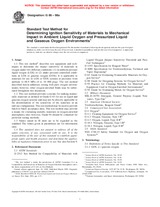We need your consent to use the individual data so that you can see information about your interests, among other things. Click "OK" to give your consent.
ASTM G86-98a
Standard Test Method for Determining Ignition Sensitivity of Materials to Mechanical Impact in Ambient Liquid Oxygen and Pressurized Liquid and Gaseous Oxygen Environments (Includes all amendments And changes 8/16/2017).
Automatically translated name:
Standard Test Method for Determining Ignition Sensitivity of Materials to Mechanical Impact in Ambient Liquid Oxygen and Pressurized Liquid and Gaseous Oxygen Environments
STANDARD published on 10.9.1998
The information about the standard:
Designation standards: ASTM G86-98a
Note: WITHDRAWN
Publication date standards: 10.9.1998
SKU: NS-57853
The number of pages: 18
Approximate weight : 54 g (0.12 lbs)
Country: American technical standard
Category: Technical standards ASTM
Annotation of standard text ASTM G86-98a :
Keywords:
compatibility, ignition, impact test, mechanical impact, pressurized oxygen, liquid oxygen, gaseous oxygen, ICS Number Code 13.220.40 (Ignitability and burning behaviour of materials and products), 95.020 (Military engineering. Military affairs. Weapons)
Additional information
| 1. Scope | ||||||||||||||||||||||
|
1.1 This test method describes test apparatus and a technique to determine the relative sensitivity of materials to mechanical impact in liquid or gaseous oxygen at pressures from 0 to 10 000 psig (0 to 68.9 MPa). The test method described herein addresses testing with pure oxygen environments; however, oxygen-enriched fluids may be substituted throughout this document. This test method utilizes an Army Ballistic Missile Agency (ABMA)-type impact tester of the type depicted in Test Method D2512 modified for pressurized testing. 1.2 This test method provides a means for ranking nonmetallic materials as defined in Guide G63 for use in liquid and gaseous oxygen systems, and is not directly applicable to the determination of the sensitivity of the material in an end-use configuration. This test method can be employed to provide batch-to-batch acceptance data. 1.3 The criteria used for the acceptance, retest or rejection of materials shall be determined by the user and are not fixed by this test method. 1.4 This standard does not purport to address all of the safety concerns, if any, associated with its use. It is the responsibility of the user of this standard to establish appropriate safety and health practices and determine the applicability of regulatory limitations prior to use. See also Section 7. |
||||||||||||||||||||||
| 2. Referenced Documents | ||||||||||||||||||||||
|
We recommend:
Technical standards updating
Do you want to make sure you use only the valid technical standards?
We can offer you a solution which will provide you a monthly overview concerning the updating of standards which you use.
Would you like to know more? Look at this page.




 Cookies
Cookies
